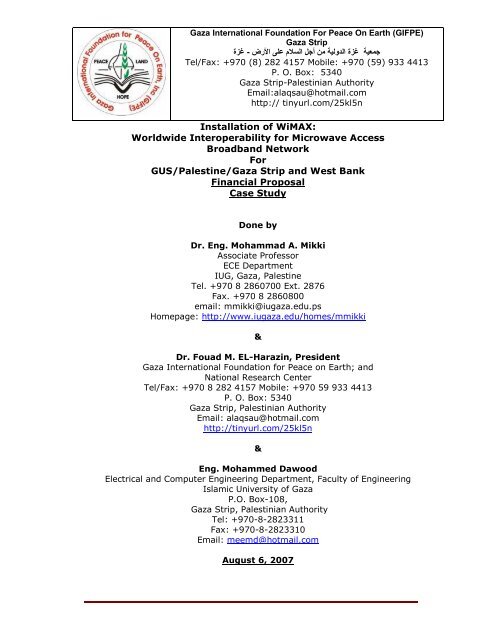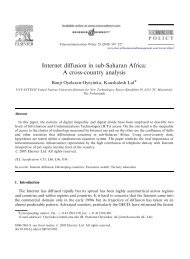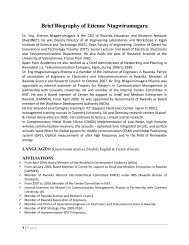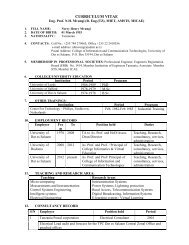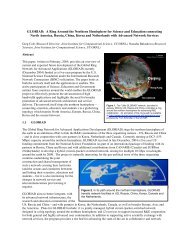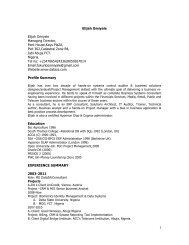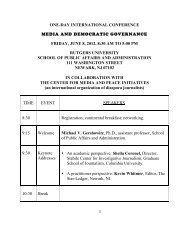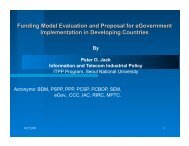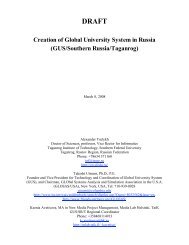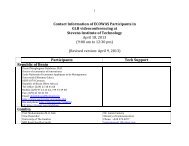Installation of WiMAX - Friends and Partners
Installation of WiMAX - Friends and Partners
Installation of WiMAX - Friends and Partners
Create successful ePaper yourself
Turn your PDF publications into a flip-book with our unique Google optimized e-Paper software.
Gaza International Foundation For Peace On Earth (GIFPE)<br />
Gaza Strip<br />
-<br />
Tel/Fax: +970 (8) 282 4157 Mobile: +970 (59) 933 4413<br />
P. O. Box: 5340<br />
Gaza Strip-Palestinian Authority<br />
Email:alaqsau@hotmail.com<br />
http:// tinyurl.com/25kl5n<br />
جمعية<br />
غزة الدولية من أجل السلام على الأرض<br />
غزة<br />
<strong>Installation</strong> <strong>of</strong> <strong>WiMAX</strong>:<br />
Worldwide Interoperability for Microwave Access<br />
Broadb<strong>and</strong> Network<br />
For<br />
GUS/Palestine/Gaza Strip <strong>and</strong> West Bank<br />
Financial Proposal<br />
Case Study<br />
Done by<br />
Dr. Eng. Mohammad A. Mikki<br />
Associate Pr<strong>of</strong>essor<br />
ECE Department<br />
IUG, Gaza, Palestine<br />
Tel. +970 8 2860700 Ext. 2876<br />
Fax. +970 8 2860800<br />
email: mmikki@iugaza.edu.ps<br />
Homepage: http://www.iugaza.edu/homes/mmikki<br />
&<br />
Dr. Fouad M. EL-Harazin, President<br />
Gaza International Foundation for Peace on Earth; <strong>and</strong><br />
National Research Center<br />
Tel/Fax: +970 8 282 4157 Mobile: +970 59 933 4413<br />
P. O. Box: 5340<br />
Gaza Strip, Palestinian Authority<br />
Email: alaqsau@hotmail.com<br />
http://tinyurl.com/25kl5n<br />
&<br />
Eng. Mohammed Dawood<br />
Electrical <strong>and</strong> Computer Engineering Department, Faculty <strong>of</strong> Engineering<br />
Islamic University <strong>of</strong> Gaza<br />
P.O. Box-108,<br />
Gaza Strip, Palestinian Authority<br />
Tel: +970-8-2823311<br />
Fax: +970-8-2823310<br />
Email: meemd@hotmail.com<br />
August 6, 2007
Financial Proposal<br />
Table <strong>of</strong> Contents<br />
Section DESCRIPTION PAGE<br />
1. INTRODUCTION 3<br />
2. Technical Description 3<br />
3. <strong>WiMAX</strong> St<strong>and</strong>ards AND DEPLOYMENT OPTIONS 4<br />
4. Licensed <strong>and</strong> License-Exempt <strong>WiMAX</strong> Technologies<br />
for Fixed Access<br />
5.<br />
6.<br />
<strong>WiMAX</strong> Equipment Specifications<br />
Design <strong>and</strong> Budget<br />
8<br />
12<br />
16<br />
7<br />
Project Sustainability<br />
References<br />
22<br />
23<br />
Page # 2
Financial Proposal<br />
1. Introduction<br />
This document provides an overview <strong>of</strong> a draft proposal for the installation <strong>of</strong> <strong>WiMAX</strong><br />
Broadb<strong>and</strong> Network for Global University System (GUS) Gaza/West Bank at different<br />
educational institutions in various campuses in Gaza Strip.<br />
This proposal explains the functional parts <strong>of</strong> a <strong>WiMAX</strong> system <strong>and</strong> its basic<br />
operation. You will learn how <strong>WiMAX</strong> can use base stations to provide high speed<br />
data connections that can be used for voice, data <strong>and</strong> video services to distances <strong>of</strong><br />
over 30 km.<br />
This document includes a technical description <strong>of</strong> <strong>WiMAX</strong> technology, <strong>WiMAX</strong><br />
st<strong>and</strong>ards, a description <strong>of</strong> the <strong>WiMAX</strong> deployment options, <strong>and</strong> licensed <strong>and</strong><br />
license-exempt <strong>WiMAX</strong> technologies for fixed access.<br />
The rest <strong>of</strong> the proposal is organized as follows: Section 2 presents technical<br />
description <strong>of</strong> <strong>WiMAX</strong>, section 3 presents the <strong>WiMAX</strong> st<strong>and</strong>ards, section 4 presents<br />
WIMAX DEPLOYMENT options including fixed access <strong>and</strong> portable access, section<br />
5 presents licensed <strong>and</strong> license-exempt WIMAX technologies for fixed access, <strong>and</strong><br />
finally, section 5 presents design <strong>and</strong> budget.<br />
2. TECHNICAL DESCRIPTION<br />
<strong>WiMAX</strong> technology is a worldwide wireless networking st<strong>and</strong>ard that addresses<br />
interoperability across IEEE 802.16* st<strong>and</strong>ard-based products. <strong>WiMAX</strong> technology<br />
<strong>of</strong>fers greater range <strong>and</strong> b<strong>and</strong>width than the wireless fidelity (Wi-Fi) family <strong>of</strong><br />
st<strong>and</strong>ards <strong>and</strong> provides a wireless alternative to wired backhaul <strong>and</strong> last mile<br />
deployments that use Data Over Cable Service Interface Specification (DOCSIS)<br />
cable modems, Digital Subscriber Line technologies (xDSL), T-carrier <strong>and</strong> E-carrier<br />
(T-x/E-x) systems, <strong>and</strong> Optical Carrier Level (OC-x) technologies.<br />
<strong>WiMAX</strong> technology can reach a theoretical 30-mile coverage radius <strong>and</strong> achieve data<br />
rates up to 75 Mbps, although at extremely long range, throughput is closer to the 1.5<br />
Mbps performance <strong>of</strong> typical broadb<strong>and</strong> services (equivalent to a T-1 line), so service<br />
providers are likely to provision rates based on a tiered pricing approach, similar to<br />
that used for wired broadb<strong>and</strong> services.<br />
The original <strong>WiMAX</strong> system was designed to operate at 10-66 GHz <strong>and</strong> it had to<br />
change to <strong>of</strong>fer broadb<strong>and</strong> wireless access (BWA) in the 2-11 GHz frequency range.<br />
To do this, the <strong>WiMAX</strong> st<strong>and</strong>ard includes variants (pr<strong>of</strong>iles) that use different<br />
combinations <strong>of</strong> radio channel types (single carrier –vs- multicarrier), modulation<br />
types, channel coding types to provide fixed, nomadic or portable services.<br />
<strong>WiMAX</strong> can provide multiple types <strong>of</strong> services to the same user with different QoS<br />
levels. For example, it is possible to install a single <strong>WiMAX</strong> transceiver in an <strong>of</strong>fice<br />
building <strong>and</strong> provide real time telephone services <strong>and</strong> best effort Internet browsing<br />
services on the same <strong>WiMAX</strong> connection. To do this, <strong>WiMAX</strong> was designed to mix<br />
contention based (competitive access) <strong>and</strong> contention free (polled access) to provide<br />
services which have different quality <strong>of</strong> service (QoS) levels.<br />
Page # 3
Financial Proposal<br />
<strong>WiMAX</strong> protocols are designed to allow for point to point (PTP), point to multipoint<br />
(PMP) <strong>and</strong> mesh networks. Operators can use the mesh configuration to allow it to<br />
link base stations without the need to install or lease interconnecting communication<br />
lines. Some <strong>of</strong> the services <strong>WiMAX</strong> operators can provide include leased line,<br />
residential broadb<strong>and</strong>, commercial broadb<strong>and</strong> <strong>and</strong> digital television (IPTV) services.<br />
<strong>WiMAX</strong> can use radio channel b<strong>and</strong>widths that can vary from 1.25 MHz to 28 MHz<br />
<strong>and</strong> data transmission rates can exceed 155 Mbps. The types <strong>of</strong> data connections on<br />
<strong>WiMAX</strong> radio channels include basic (physical connection), primary (device control),<br />
secondary (configuration) <strong>and</strong>, transport (user data).<br />
WIMAX systems extend the range <strong>of</strong> WIMAX systems through the use <strong>of</strong> directional<br />
antennas.<br />
3. WIMAX STANDARDS AND DEPLOYMENT OPTIONS<br />
It is <strong>of</strong>ten thought that <strong>WiMAX</strong> is one homogenous technology when in fact it is a<br />
trade name for a group <strong>of</strong> IEEE wireless st<strong>and</strong>ards. In that respect, <strong>WiMAX</strong> <strong>and</strong> Wi-Fi<br />
are analogous. Wi-Fi is not a st<strong>and</strong>ard, but a trade name that can be applied to a<br />
series <strong>of</strong> 802.11 IEEE st<strong>and</strong>ards, including 802.11b, 802.11a, <strong>and</strong> 802.11g.<br />
<strong>WiMAX</strong> is a worldwide certification addressing interoperability across IEEE 802.16<br />
Working Group st<strong>and</strong>ards-based products. The IEEE 802.16 st<strong>and</strong>ard with specific<br />
revisions addresses two usage models:<br />
• Fixed (IEEE 802.16-2004)<br />
• Portable (802.16 REV E).<br />
3.1 Fixed (IEEE 802.16-2004)<br />
IEEE 802.16-2004 is a fixed wireless access technology, meaning that it is designed<br />
to serve as a wireless DSL replacement technology, to compete with the incumbent<br />
DSL or broadb<strong>and</strong> cable providers or to provide basic voice <strong>and</strong> broadb<strong>and</strong> access in<br />
underserved areas where no other access technology exists; examples include<br />
developing countries <strong>and</strong> rural areas in developed countries where running copper<br />
wire or cable does not make economic sense. 802.16-2004 is also a viable solution<br />
for wireless backhaul for WiFi access points or potentially for cellular networks, in<br />
particular if licensed spectrum is used. Finally, in certain configurations, <strong>WiMAX</strong> fixed<br />
can be used to provide much higher data rates <strong>and</strong> therefore be used as a T-1<br />
replacement option for high-value corporate subscribers.<br />
Typically, the CPE (consumer premise equipment) consists <strong>of</strong> an outdoor unit<br />
(antenna, etc.) <strong>and</strong> an indoor modem, meaning that a technician is required to get a<br />
commercial or residential subscriber connected to the network. In certain instances, a<br />
self-installable indoor unit can be used, in particular when the subscriber is in<br />
relatively close proximity to the transmitting base station. As it does, the fixed<br />
wireless technology would introduce a degree <strong>of</strong> nomadic capability since the<br />
subscriber could travel with the CPE <strong>and</strong> use it in other fixed locations - <strong>of</strong>fice, hotel<br />
<strong>and</strong> c<strong>of</strong>fee shop, etc. Additionally, self-installable CPEs should make 802.16-2004<br />
more economically viable as a large part <strong>of</strong> the customer acquisition cost<br />
Page # 4
Financial Proposal<br />
(installation, CPE) is dramatically reduced. Although it is technically feasible to<br />
design an 802.16-2004 data card, h<strong>and</strong>held devices with an embedded 802.16-2004<br />
solution do not appear to be a top priority within the industry at this time.<br />
The fixed version <strong>of</strong> the <strong>WiMAX</strong> st<strong>and</strong>ard was approved in June 2004. Further, base<br />
station <strong>and</strong> CPE chipsets from the major vendors are just reaching the point where<br />
potential customers are sampling them with the Intel Rosedale chipset sampling<br />
since September 2004 <strong>and</strong> Fujitsu having announced its first <strong>WiMAX</strong> chipset.<br />
The IEEE 802.16-2004 st<strong>and</strong>ard (which revises <strong>and</strong> replaces IEEE 802.16a <strong>and</strong><br />
802.16REVd versions) is designed for fixed-access usage models. This st<strong>and</strong>ard<br />
may be referred to as “fixed wireless” because it uses a mounted antenna at the<br />
subscriber’s site. The antenna is mounted to a ro<strong>of</strong> or mast, similar to a satellite<br />
television dish. IEEE 802.16-2004 also addresses indoor installations, in which case<br />
it may not be as robust as in outdoor installations.<br />
The 802.16-2004 st<strong>and</strong>ard is a wireless solution for fixed broadb<strong>and</strong> Internet access<br />
that provides an interoperable, carrier-class solution for the last mile. The Intel<br />
<strong>WiMAX</strong> solution for fixed access operates in the licensed 2.5-GHz, 3.5-GHz <strong>and</strong><br />
license-exempt 5.8-GHz b<strong>and</strong>s. This technology provides a wireless alternative to the<br />
cable modem, digital subscriber lines <strong>of</strong> any type (xDSL), transmit/exchange (Tx/Ex)<br />
circuits <strong>and</strong> optical carrier level (OC-x) circuits.<br />
The 802.16-2004 st<strong>and</strong>ard allows for near line <strong>of</strong> sight operation (NLOS) <strong>and</strong> better<br />
resiliency to multipath interference than the 802.11* st<strong>and</strong>ard <strong>and</strong> revisions. This<br />
enables operators to deploy base stations further away from subscriber stations <strong>and</strong><br />
within areas that have obstructed views to the subscriber, such as within a forest or<br />
among buildings in a densely populated area. The ability <strong>of</strong> a solution based on the<br />
802.16-2004 st<strong>and</strong>ard to cope with multipath interference allows it to operate in<br />
various locations under extreme conditions, although deploying the solution in more<br />
favorable conditions can improve performance.<br />
Figure 1 <strong>and</strong> Figure 2 show the <strong>WiMAX</strong> network topology for the fixed access usage<br />
model.<br />
Figure 1: <strong>WiMAX</strong> Network Topology for Fixed Access Usage Model<br />
Page # 5
Financial Proposal<br />
Figure 2: Fixed <strong>WiMAX</strong> deployment <strong>and</strong> usage models.<br />
A typical <strong>WiMAX</strong> Scenario to be used in the GUS/Palestine/Gaza Strip <strong>and</strong> West<br />
Bank project is shown in Figure 3.<br />
Figure 3: A typical <strong>WiMAX</strong> Scenario to be used in the GUS/Palestine/Gaza Strip<br />
<strong>and</strong> West Bank project.<br />
Page # 6
Financial Proposal<br />
Benefits <strong>of</strong> Adopting a <strong>WiMAX</strong> Fixed Solution<br />
The ability to operate a st<strong>and</strong>ardized solution in both a licensed <strong>and</strong> a license-exempt<br />
b<strong>and</strong> (see section 4) is one <strong>of</strong> the benefits <strong>of</strong> <strong>WiMAX</strong> solutions for deployments<br />
around the world. Both licensed <strong>and</strong> license-exempt <strong>WiMAX</strong> solutions provide<br />
significant advantages over wired solutions. The adoption <strong>of</strong> license-exempt <strong>and</strong><br />
licensed <strong>WiMAX</strong> solutions is being driven by the following additional benefits:<br />
1. Scalability: The 802.16-2004 st<strong>and</strong>ard supports flexible radio frequency (RF)<br />
channel b<strong>and</strong>widths <strong>and</strong> reuse <strong>of</strong> these frequency channels as a way to<br />
increase network capacity. The st<strong>and</strong>ard also specifies support for Transmit<br />
Power Control (TPC) <strong>and</strong> channel quality measurements as additional tools to<br />
support efficient spectrum use. The st<strong>and</strong>ard has been designed to scale up to<br />
hundreds or even thous<strong>and</strong>s <strong>of</strong> users within one RF channel. Operators can<br />
re-allocate spectrum through sectoring as the number <strong>of</strong> subscribers grows.<br />
Support for multiple channels enables equipment makers to provide a means<br />
to address the range <strong>of</strong> spectrum use <strong>and</strong> allocation regulations faced by<br />
operators in diverse international markets.<br />
2. Cost effectiveness: The wireless medium used by <strong>WiMAX</strong> enables service<br />
providers to circumvent costs Associated with deploying wires, such as time<br />
<strong>and</strong> labor.<br />
3. Flexibility: A wireless medium enables deployment <strong>of</strong> an access solution over<br />
long distances across a variety <strong>of</strong> terrains in different countries.<br />
4. St<strong>and</strong>ard-based: The <strong>WiMAX</strong> Forum helps support interoperability <strong>and</strong><br />
coordination between vendors developing 802.16-2004 compliant products by<br />
testing <strong>and</strong> certifying the compliance <strong>of</strong> products.<br />
Antennas for Fixed Wireless Applications<br />
Directional antennas increase the fade margin by adding more gain. This increases<br />
the link availability as shown by K-factor comparisons between directional <strong>and</strong> omnidirectional<br />
antennas. Delay spread is further reduced by directional antennas at both<br />
the Base Station <strong>and</strong> CPE. The antenna pattern suppresses any multi-path signals<br />
that arrive in the sidelobes <strong>and</strong> backlobes. The effectiveness <strong>of</strong> these methods has<br />
been proven <strong>and</strong> demonstrated in successful deployments, in which the service<br />
operates under significant NLOS fading.<br />
Adaptive antenna systems (AAS) are an optional part <strong>of</strong> the 802.16 st<strong>and</strong>ard. These<br />
have beamforming properties that can steer their focus to a particular direction or<br />
directions. This means that while transmitting, the signal can be limited to the<br />
required direction <strong>of</strong> the receiver; like a spotlight. Conversely when receiving, the<br />
AAS can be made to focus only in the direction from where the desired signal is<br />
coming from. They also have the property <strong>of</strong> suppressing cochannel interference<br />
from other locations. AASs are considered to be future developments that could<br />
eventually improve the spectrum re-use <strong>and</strong> capacity <strong>of</strong> a <strong>WiMAX</strong> network.<br />
Page # 7
Financial Proposal<br />
3.2 Portable (802.16 REV E)<br />
The IEEE 802.16e st<strong>and</strong>ard is an amendment to the 802.16- 2004 base specification<br />
<strong>and</strong> targets the mobile market by adding portability <strong>and</strong> the ability for mobile clients<br />
with IEEE 802.16e adapters to connect directly to the <strong>WiMAX</strong> network to the<br />
st<strong>and</strong>ard.<br />
The 802.16e st<strong>and</strong>ard uses Orthogonal Frequency Division Multiple Access<br />
(OFDMA), which is similar to OFDM in that it divides the carriers into multiple<br />
subcarriers. OFDMA, however, goes a step further by then grouping multiple<br />
subcarriers into sub-channels. A single client or subscriber station might transmit<br />
using all <strong>of</strong> the sub-channels within the carrier space, or multiple clients might<br />
transmit with each using a portion <strong>of</strong> the total number <strong>of</strong> sub-channels<br />
simultaneously.<br />
4. LICENSED AND LICENSE-EXEMPT WIMAX TECHNOLOGIES FOR FIXED<br />
ACCESS<br />
Governments around the world recognize the value <strong>of</strong> innovations associated with<br />
open st<strong>and</strong>ards <strong>and</strong> license-exempt solutions <strong>and</strong> have established frequency b<strong>and</strong>s<br />
available for use by licensed <strong>and</strong> license-exempt <strong>WiMAX</strong> technologies. However, to<br />
impose some control over license-exempt solutions to mitigate the potential for<br />
interference, some governments stipulate power requirements for highpower<br />
<strong>and</strong> low-power operations.<br />
Each geographical region defines <strong>and</strong> regulates its own set <strong>of</strong> licensed <strong>and</strong> licenseexempt<br />
b<strong>and</strong>s, as shown in Table 1. To meet global regulatory requirements <strong>and</strong><br />
allow providers to use all available spectrums within these b<strong>and</strong>s, the 802.16-2004<br />
st<strong>and</strong>ard supports channel sizes between 1.5 MHz <strong>and</strong> 20 MHz.<br />
Table 1: B<strong>and</strong>s <strong>and</strong> frequencies available for <strong>WiMAX</strong>.<br />
4.1 LICENSED BANDS: 2.5 GHZ AND 3.5 GHZ<br />
The 2.5 GHz b<strong>and</strong> has been allocated in much <strong>of</strong> the world, including North America,<br />
Latin America, Western <strong>and</strong> Eastern Europe <strong>and</strong> parts <strong>of</strong> Asia-Pacific as a licensed<br />
b<strong>and</strong>. Each country allocates the b<strong>and</strong> differently, so the spectrum allocated across<br />
regions can range from 2.6 GHz to 4.2 GHz. A system operating in the licensed b<strong>and</strong><br />
has an advantage over a system operating in an unlicensed b<strong>and</strong> in that it has a<br />
more generous downlink power budget <strong>and</strong> can better support indoor antennas.<br />
Page # 8
Financial Proposal<br />
In the US, the Federal Communications Commission (FCC) has created the<br />
Broadb<strong>and</strong> Radio Service (BRS), previously called the multi-channel multipoint<br />
distribution system (MMDS), for wireless broadb<strong>and</strong> access. The restructuring that<br />
followed has allowed for the opening <strong>of</strong> the 2.495 GHz to 2.690 GHz b<strong>and</strong>s for<br />
licensed solutions such as 2.5GHz in <strong>WiMAX</strong>.<br />
In Europe, the European Telecommunications St<strong>and</strong>ards Institute (ETSI) has allotted<br />
the 3.5 GHz b<strong>and</strong>, originally used for wireless local loop (WPLL), for licensed <strong>WiMAX</strong><br />
solutions.<br />
4.2 LICENSE-EXEMPT BAND: 5 GHZ<br />
The majority <strong>of</strong> countries around the world have embraced the 5 GHz spectrum for<br />
license-exempt communications. The 5.15 GHz <strong>and</strong> 5.85 GHz b<strong>and</strong>s have been<br />
designated as license exempt in much <strong>of</strong> the world.<br />
Approximately 300 MHz <strong>of</strong> spectrum is available in many markets globally, <strong>and</strong> an<br />
additional 255 MHz <strong>of</strong> license-exempt 5 GHz spectrum is available in highly<br />
populated markets like the United States. Some governments <strong>and</strong> service providers<br />
are concerned that interference resulting from the availability <strong>of</strong> too many licenseexempt<br />
b<strong>and</strong>s could affect critical public <strong>and</strong> government communication networks,<br />
such as radar systems.<br />
These countries <strong>and</strong> entities have become active in establishing limited control<br />
requirements for 5 GHz spectrums. For example, the United Kingdom is currently<br />
introducing restrictions on certain 5 GHz channels <strong>and</strong> considering enforcement <strong>of</strong><br />
the use <strong>of</strong> the DFS (Dynamic Frequency Select) function. In Mexico, regulations<br />
requiring the use <strong>of</strong> spectrum “to benefit the people” have influenced the government<br />
to take a protectionist <strong>and</strong> revenue generating approach toward licensing. The<br />
Mexican government is moving toward licensing at least one <strong>of</strong> the 5 GHz b<strong>and</strong>s,<br />
with 5.8 GHz currently a primary c<strong>and</strong>idate.<br />
4.3 CHALLENGES OF DEPLOYING A LICENSE-EXEMPT WIMAX SOLUTION<br />
Licensed <strong>and</strong> license-exempt <strong>WiMAX</strong> solutions face common challenges related to<br />
government regulations, infrastructure placement, <strong>and</strong> interference. However,<br />
license-exempt solutions have more to prove in environments where licensed<br />
solutions are seen as more stable <strong>and</strong> reliable.<br />
The benefits <strong>of</strong> a license-exempt <strong>WiMAX</strong> solution, including cost-effectiveness <strong>and</strong><br />
easier entrance for new providers, can lead to additional hurdles. Easier entrance<br />
<strong>and</strong> lower costs allow more operators to deploy solutions. More deployments mean<br />
increased RF usage, a higher possibility <strong>of</strong> interference, <strong>and</strong> more competition for<br />
prime real estate for deployment. RF interference <strong>and</strong> the physical placement <strong>of</strong> the<br />
infrastructure are the primary challenges associated with deploying a license-exempt<br />
solution.<br />
Two major challenges to overcome in deploying a <strong>WiMAX</strong> solution are:<br />
1. RF interference – An interfering RF source disrupts a transmission <strong>and</strong><br />
decreases performance by making it difficult for a receiving station to interpret<br />
a signal. Forms <strong>of</strong> RF interference frequently encountered are multipath<br />
Page # 9
Financial Proposal<br />
interference <strong>and</strong> attenuation. Multipath interference is caused by signals<br />
reflected <strong>of</strong>f objects resulting in reception distortion.<br />
Attenuation occurs when an RF signal passes through a solid object, such as<br />
a tree, reducing the strength <strong>of</strong> the signal <strong>and</strong> subsequently its range.<br />
Overlapping interference from an adjacent base station can generate r<strong>and</strong>om<br />
noise.<br />
1<br />
License-exempt solutions have to contend with more interference then<br />
licensed solutions, including intra-network interference caused by the service<br />
provider’s own equipment operating in close proximity, <strong>and</strong> external network<br />
interference. Licensed solutions must only contend with inter-network<br />
interference. For license-exempt solutions, RF interference is a more serious<br />
issue in networks with centralized control than in a shared network because<br />
the base station coordinates all traffic <strong>and</strong> b<strong>and</strong>width allocation.<br />
2. Infrastructure placement – Infrastructure location refers to the physical<br />
location <strong>of</strong> infrastructure elements. Infrastructure placement can be an issue<br />
for both licensed <strong>and</strong> license-exempt solutions. However, infrastructure<br />
placement presents some special considerations for license-exempt solutions.<br />
Service providers are quickly deploying solutions in specific areas to stake out<br />
territory with high subscriber density <strong>and</strong> spectrum efficiency. Such areas<br />
include higher ground, densely populated or population growth areas, <strong>and</strong><br />
areas with a less crowded RF spectrum. In addition, the physical structure that<br />
houses or supports the base station must be RF compatible, A metal farm silo,<br />
for example, may distort signals, or a tree swaying in the wind may change<br />
signal strength.<br />
4.4 SOLVING THE CHALLENGES OF DEPLOYING A LICENSE-EXEMPT WIMAX<br />
SOLUTION<br />
In a license-exempt network, proper network design <strong>and</strong> infrastructure placement are<br />
critical. Interference mitigation through planning can greatly reduce interference <strong>and</strong><br />
improve the quality <strong>of</strong> a service as shown in Figure 4 <strong>and</strong> described below:<br />
Figure 4: a properly deployed license-exempt <strong>WiMAX</strong> solution<br />
Page # 10
Financial Proposal<br />
• Subscriber site (1) – Pr<strong>of</strong>essional installation <strong>of</strong> a subscriber station should include<br />
site surveys to gather information, such as RF activity within the area, <strong>and</strong> determine<br />
antenna types <strong>and</strong> tilt angles required for optimum RF reception.<br />
• Antennas (2) – In addition to redundant links <strong>and</strong> proper antenna tilt angles, array<br />
gain <strong>and</strong> diversity gain can help optimize RF reception.<br />
– Array Gain – The gain achieved by using multiple antennas so that the signal adds<br />
coherently.<br />
– Diversity Gain – The gain achieved by using multiple paths, so that if a signal is<br />
compromised in one <strong>of</strong> the paths, overall performance is still maintained. Effectively,<br />
diversity gain refers to techniques used at the transmitter or receiver to achieve<br />
multiple “looks” at a fading channel. These schemes improve performance by<br />
increasing the stability <strong>of</strong> the received signal strength in the presence <strong>of</strong> wireless<br />
signal fading. Diversity may be exploited in the spatial (antenna), temporal (time), or<br />
spectral (frequency) dimensions.<br />
• Central <strong>of</strong>fice (CO) or point-<strong>of</strong>-presence (POP) (3) –<br />
The CO or POP is the provider’s network operation center. The proper design <strong>and</strong><br />
deployment <strong>of</strong> the network operation center includes:<br />
– Identifying user requirements<br />
– Pr<strong>of</strong>essional installation <strong>of</strong> base stations <strong>and</strong> antennas with appropriate tilt angles<br />
– Providing a broadb<strong>and</strong> service with typically at least 1Mbps per subscriber<br />
– Connecting properly to the backbone<br />
– Connecting to voice services, such as public switched telephone networks<br />
(PSTNs), <strong>and</strong> media gateways<br />
– Implementing traffic management, routers, <strong>and</strong> firewalls<br />
– Establishing a means to collect network statistics<br />
• Forward deployed base station or cells (4) –<br />
Providing 24/7 access, a sturdy RF-friendly structure, <strong>and</strong> shielding from weather<br />
elements can help reduce interference <strong>and</strong> improve quality <strong>of</strong> service.<br />
4.5 IMPROVING LICENSE-EXEMPT WIMAX DEPLOYMENTS USING ANTENNA<br />
TECHNIQUES<br />
Several solutions <strong>of</strong> license-exempt <strong>WiMAX</strong> deployments are described below <strong>and</strong><br />
illustrated in Figure 5.<br />
.<br />
Page # 11
Financial Proposal<br />
Figure 5: Improving resiliency using channelization <strong>and</strong> smart antenna<br />
technology<br />
Antenna technology can by used to improve transmissions in two ways—through<br />
using diversity techniques <strong>and</strong> through using advanced antenna systems <strong>and</strong><br />
switching techniques. These techniques can improve resiliency <strong>and</strong> signal-to-noise<br />
ratio but do not guarantee the transmission will not be affected by interference.<br />
Diversity Techniques – Diversity techniques, such as multiple antennas, receivers, or<br />
transmitters, reduce multipath fading by providing alternate paths for the signal. The<br />
system selects the appropriate receiver or transmitter depending on the implemented<br />
technique. Appropriate space-time codes are applied to determine the best path. The<br />
availability <strong>of</strong> alternate paths enables improved network resiliency.<br />
Advance Antenna Systems <strong>and</strong> Switching – This approach uses a beam forming <strong>and</strong><br />
steering technique in which the angle, path <strong>and</strong> width <strong>of</strong> the beam is altered. By<br />
focusing the beam at a given point through power <strong>and</strong> RF coding, the quality <strong>of</strong> a<br />
signal can be improved.<br />
5. WIMAX EQUIPMENT SPECIFICATIONS<br />
This section describes the <strong>WiMAX</strong> equipment technical specification.<br />
Two likely types <strong>of</strong> base stations include:<br />
1. A st<strong>and</strong>ard base station:<br />
• Basic <strong>WiMAX</strong> implementation (m<strong>and</strong>atory capabilities only).<br />
• St<strong>and</strong>ard RF output power for a lower cost base station (vendor specific).<br />
2. A full featured base station<br />
• Higher RF output power than st<strong>and</strong>ard base station (vendor specific).<br />
• Tx/Rx diversity combined with space-time coding <strong>and</strong> MRC reception.<br />
• Sub-channeling.<br />
• ARQ.<br />
Both the st<strong>and</strong>ard <strong>and</strong> full-featured base stations can be <strong>WiMAX</strong> compliant, however<br />
the performance that can be achieved by each is quite different. Table 2 shows the<br />
amount <strong>of</strong> differentiation between the two different types, for a reference system<br />
Page # 12
Financial Proposal<br />
configuration. It is important to underst<strong>and</strong> that there are a number <strong>of</strong> options within<br />
<strong>WiMAX</strong> that give operators <strong>and</strong> vendors the ability to build networks that best fit their<br />
application <strong>and</strong> business case. *The uplink maximum throughput in Table 2 assumes<br />
that a single subchannel is used to extend the cell edge as far as possible.<br />
Page # 13
Financial Proposal<br />
Table 2: Full featured base station versus St<strong>and</strong>ard base station comparison<br />
6. GUS/GAZA STRIP AND WEST BANK WIMAX NETWORK DESIGN AND<br />
BUDGET<br />
6.1 Gaza Strip Map<br />
This section describes the required equipment for deploying WIMAX network for<br />
GUS/Palestine/Gaza Strip <strong>and</strong> West Bank project. The project will connect Gaza<br />
strip universities <strong>and</strong> schools with <strong>WiMAX</strong> network.<br />
The Gaza Strip area is approximately 365 K . It has a geographic location with<br />
Latitude/Longitude: 31/34. Also it has a long beach about 41 Km. the weather is<br />
maritime temperature over sea. The l<strong>and</strong> is a seaboard means doesn’t contain<br />
mountains, rivers <strong>and</strong> density forests. Gaza Strip geographical map is shown in Figure 6.<br />
Page # 14
Financial Proposal<br />
Figure 6: Gaza Strip Map<br />
The l<strong>and</strong> property <strong>of</strong> Gaza Strip is divided into three levels as shown in Table 3.<br />
Table 3: Levels <strong>of</strong> l<strong>and</strong> property <strong>of</strong> Gaza Strip<br />
region<br />
The South<br />
The Middle<br />
The North<br />
Height above the sea<br />
70 meter<br />
30 meter<br />
50 meter<br />
Page # 15
Financial Proposal<br />
Figure 7 shows these Levels <strong>of</strong> l<strong>and</strong> property <strong>of</strong> Gaza Strip geographically.<br />
+50 M<br />
North<br />
+30 M<br />
Middle<br />
+70 M<br />
South<br />
Figure 7: Levels <strong>of</strong> l<strong>and</strong> property <strong>of</strong> Gaza Strip<br />
Page # 16
Financial Proposal<br />
6.2 Gaza Strip Universities <strong>and</strong> Schools Distribution<br />
Table 4 shows the Distribution <strong>of</strong> students at K-12 Schools in Gaza Strip<br />
Table 4: Distribution <strong>of</strong> students at K-12 Schools in Gaza Strip<br />
Number <strong>of</strong> Students Number <strong>of</strong> K-12 schools Region<br />
18614 45 Gaza<br />
9133 19 North Gaza<br />
10527 23 Khan Younos<br />
7141 15 Rafah<br />
8450 19 Middle <strong>of</strong> Gaza<br />
53865<br />
Table 5 shows the Distribution <strong>of</strong> students at Higher Education Institution in<br />
Gaza Strip (H.E.I) 2005/2006<br />
Table 5: Distribution <strong>of</strong> students at Higher Education Institution in Gaza Strip<br />
(H.E.I) 2005/2006<br />
Higher Education<br />
Number <strong>of</strong> Students<br />
Institution<br />
Traditional Universities 25472<br />
Open Universities 19957<br />
University Colleges 2622<br />
Community Colleges 6887<br />
Total 54934<br />
Table 6 shows the list <strong>of</strong> universities <strong>and</strong> colleges in Gaza strip based on their<br />
categories.<br />
Table 6: list <strong>of</strong> universities <strong>and</strong> colleges in Gaza strip based on their categories<br />
1<br />
2<br />
3<br />
4<br />
Traditional<br />
Universities<br />
Al-Azhar<br />
University<br />
The Islamic<br />
University<br />
Al-Aqsa<br />
University<br />
Open<br />
Universities<br />
Al-Quds Open<br />
University<br />
University<br />
Colleges<br />
Palestine<br />
Technical Deir Al-<br />
Balah<br />
Science <strong>and</strong><br />
Technology<br />
College<br />
Palestine Nursing<br />
Al-Dawa College<br />
Community<br />
Colleges<br />
Intermediate<br />
Studies - Al-<br />
Azhar<br />
Applied Science<br />
& Tech – Al-<br />
Islamiyah<br />
Gaza<br />
Community<br />
Gaza Comm.<br />
For Tourist<br />
Studies<br />
Page # 17
Financial Proposal<br />
6.3 Equipment Cost<br />
Figure 8 shows the key components <strong>of</strong> a basic <strong>WiMAX</strong> radio system. This diagram<br />
shows that the major components <strong>of</strong> a <strong>WiMAX</strong> system include subscriber station<br />
(SS), a base station (BS) <strong>and</strong> interconnection gateways to datacom (e.g. Internet)<br />
<strong>and</strong> telecom (e.g. PSTN). An antenna <strong>and</strong> receiver (subscriber station) in the home<br />
or business converts the microwave radio signals into broadb<strong>and</strong> data signals for<br />
distribution in the home. In this example, a <strong>WiMAX</strong> system is being used to provide<br />
telephone <strong>and</strong> broadb<strong>and</strong> data communication services. When used for telephone<br />
services, the <strong>WiMAX</strong> system converts broadcast signals to an audio format (such as<br />
VoIP) for distribution to IP telephones or analog telephone adapter (ATA) boxes.<br />
When <strong>WiMAX</strong> is used for broadb<strong>and</strong> data, the <strong>WiMAX</strong> system also connects the<br />
Internet through a gateway to the Internet. This example also shows that the <strong>WiMAX</strong><br />
system can reach distances <strong>of</strong> up to 50 km when operating at lower frequencies (2-<br />
11 GHz).<br />
Figure 8: A typical <strong>WiMAX</strong> Scenario to be used in the GUS (Gaza/West Bank)<br />
project.<br />
Table 7 shows the Frequency Allocation in Gaza Strip.<br />
Institution/ Company<br />
Used Frequency<br />
Palestinian Cellular Communications Company<br />
(Jawwal)<br />
806-880 MHz.<br />
Palestinian Communications Company<br />
(PALTEL)<br />
13, 18, 21 GHz <strong>and</strong> upper 6<br />
GHz<br />
Fusion Internet Company (ISP)<br />
4.2, 2.4 GHz ISM<br />
UNRWA<br />
3.2 GHz<br />
Page # 18
Financial Proposal<br />
Figure 9 shows the <strong>WiMAX</strong> network design for Gaza Strip.<br />
G1<br />
G2<br />
G3<br />
G4<br />
G5<br />
Figure 9: <strong>WiMAX</strong> network design for Gaza Strip<br />
Our design is depend on dividing the area into cells, as shown in Figure 9 above.<br />
Each cell covers approximately area <strong>of</strong> 5 Km radius, <strong>and</strong> can serve 120 users at<br />
least, with b<strong>and</strong>width <strong>of</strong> 512 Kbps in the worst case. Each cell contains one base<br />
station, with the following specifications:<br />
Each cell will be bridged with the others by backhaul system that can support<br />
70Mbps data rate, <strong>and</strong> can cover distance <strong>of</strong> 20 mile at least. Table 8 shows the<br />
<strong>WiMAX</strong> equipment required for the GUS/Palestine/Gaza Strip <strong>and</strong><br />
West Bank project <strong>and</strong> Budget.<br />
Page # 19
Financial Proposal<br />
Table 8: <strong>WiMAX</strong> equipment required for the GUS/Palestine/Gaza Strip<br />
<strong>and</strong> West Bank project <strong>and</strong> Budget<br />
# Item Quantity Price US$ T Price US$<br />
1.<br />
<strong>WiMAX</strong> Base Station with 6<br />
sectors, 60 degrees sectorial<br />
antennas <strong>and</strong> cables, total 5 123,500 617,500<br />
capacity - 72Mbps Net FD per<br />
BS<br />
2.<br />
- Complete Subscriber Unit,<br />
Indoor Network Interface<br />
Unit <strong>and</strong> Power supply<br />
+ Outdoor radio unit, Integrated<br />
antenna, Indoor to Outdoor<br />
140 2080 291,200<br />
Cat5 20 Meter cable included. ,<br />
Full Data Bridge, 6Mbps data<br />
rate<br />
3.<br />
Full Point to Point link, 54Mbps<br />
Gross, including IDU + ODU + 4 12350 49,400<br />
Antennas + cables<br />
4. Steel Tower for Clients 140 156 21,840<br />
5. Cisco 1700 router 140 1040 145,600<br />
6. Cisco 3600 router 5 2765 13,825<br />
Total<br />
US $<br />
1,139,365<br />
NOTE:<br />
The above cost includes only the basic local design for Gaza Strip, but in case we<br />
want to extend the network to connect to West Bank <strong>and</strong> other countries, the cost<br />
may vary depending on frequency licensing governmental rules in the area.<br />
6.4 Personnel Cost<br />
Assistance in the detailed Network design includes:<br />
1. Specify equipment<br />
2. Consideration <strong>of</strong> space requirements for facilities to house the electronic<br />
equipment <strong>and</strong> the required environment to meet the equipment's specifications<br />
3. Assist in the development <strong>of</strong> selected user locations, interface equipment, <strong>and</strong><br />
networking platform for the delivery <strong>of</strong> high-speed data transmission services.<br />
4. Recommendations on the operating platform gear <strong>and</strong> network monitoring<br />
system<br />
5. Recommend network <strong>and</strong> systems integration<br />
6. Provide equipment estimates<br />
Page # 20
Financial Proposal<br />
The project period is 3 years. This period is to install the <strong>WiMAX</strong> in Gaza Strip.<br />
The project team consists <strong>of</strong> qualified <strong>and</strong> experienced personnel. The project team<br />
utilizes a matrix organization system in which a designated Project Manager is assigned<br />
the responsibility for the administrative activities <strong>of</strong> the project team. The technical<br />
manager is assigned the technical activities <strong>of</strong> the project team. Table 9 shows the<br />
personnel needed to implement the project <strong>and</strong> their cost.<br />
Table 9: personnel needed to implement the project <strong>and</strong> their cost<br />
Personnel title Number <strong>of</strong> Monthly Mont Total cost Responsibilities<br />
Personnel Salary hs<br />
US$<br />
Project<br />
Coordinator<br />
1 3000 36 108,000 Project Principal <strong>and</strong><br />
Manager<br />
Technical<br />
Manager<br />
Technical<br />
Engineer<br />
1 2000 36 72,000 Project technical<br />
management<br />
4 1000 36 144,000 Logical network<br />
design <strong>of</strong> the<br />
project, supervision<br />
<strong>of</strong> implementation<br />
Technician 10 500 36 180,000 Physical network<br />
work <strong>and</strong> installation<br />
<strong>of</strong> equipment<br />
Secretary 1 700 36 25,200 Secretarial work<br />
Technical<br />
Consultant<br />
2 1500 36 108,000 Providing technical<br />
consultation<br />
services to project<br />
coordinator <strong>and</strong><br />
technical manager<br />
Gr<strong>and</strong> Total <strong>of</strong> Personnel cost US$ 637,200<br />
6.4.1 Project Management Services<br />
1. Providing overall project direction<br />
2. Assist with bid document preparation<br />
3. Coordinate all external <strong>and</strong> internal communications<br />
4. Coordinate all work associated with contractors<br />
5. Distribute all necessary project related documentation.<br />
6.4.2 Project Consultation Services<br />
1. Provide consultation services during construction, answer questions, etc…<br />
2. Meet periodically with the sponsors <strong>of</strong> the project to provide general project<br />
management assistance.<br />
Page # 21
Financial Proposal<br />
Travel Cost<br />
Table 10 shows the travel cost.<br />
Table 10: Travel cost<br />
Travel Unit Number <strong>of</strong> units<br />
Unit<br />
rate Total cost<br />
International Travel Per journey 1 per month (36 months) 2000 36,000<br />
Local Transportation Per month 1 per month (36 months) 500 18,000<br />
Total Travel US$ 54,000<br />
Local Office/Project Cost<br />
Table 11 shows the Local Office/Project cost.<br />
Table 11: Local Office/Project cost<br />
Local Office/Project Costs<br />
Number<br />
<strong>of</strong> units Unit rate<br />
Office Running Costs (tel, phone, electricity etc)<br />
Total<br />
provision 1 100,000 100,000<br />
total Local Office/Project Costs 100,000<br />
Telecommunication Costs<br />
Table 12 shows the Telecommunication cost.<br />
Table 12: Telecommunication cost<br />
Telecommunication Costs Per annum 3 35,000 105,000<br />
Subtotal Other 105,000<br />
Page # 22
Financial Proposal<br />
Total Project Cost<br />
Table 13 shows the Total Project cost.<br />
Table 13: Total Project cost<br />
Equipment (Table 8) 1,139,365<br />
Personnel Salaries<br />
• Administrative cost<br />
• Management cost<br />
• Consultation cost<br />
• Implementation cost 637,200<br />
travel 54,000<br />
Local Office/Project Costs 100,000<br />
Telecommunication Costs 105,000<br />
Total Project Cost US $ 2,035,565<br />
7. Project Sustainability<br />
At its completion date (the end <strong>of</strong> the 3 year financing period), the GUS (Gaza/West<br />
Bank) project aims to be operating independently <strong>and</strong> self-sufficiently, <strong>of</strong>fering<br />
broadb<strong>and</strong> network services (video conferencing, audio conferencing, Telephony,<br />
video on dem<strong>and</strong>, etc.) to the Gaza Strip area. GUS (Gaza/West Bank) aims to <strong>of</strong>fer<br />
a large number <strong>of</strong> high-quality eLearning <strong>and</strong> eHealthcare services across Gaza Strip<br />
through the participating institutions <strong>and</strong> schools. All partners are highly reputable<br />
universities <strong>and</strong> schools that already have the expertise <strong>and</strong> know-how in delivering<br />
classroom courses. The international partners will help to provide the training<br />
required to transform online teaching <strong>and</strong> learning methodologies. The services<br />
<strong>of</strong>fered through the project will be charged based on its quality <strong>and</strong> duration. An NGO<br />
will be established at the end <strong>of</strong> the project to supervise <strong>and</strong> manage the project <strong>and</strong><br />
convert it into a business model.<br />
Page # 23
Financial Proposal<br />
REFERENCES<br />
[1] Underst<strong>and</strong>ing Wi-Fi <strong>and</strong> <strong>WiMAX</strong> as Metro-Access Solutions, Intel, White Paper<br />
[2] Considerations for deploying mobile <strong>WiMAX</strong> at various frequencies, White Paper<br />
[3] St<strong>and</strong>ards versus Proprietary Solutions - The Case for <strong>WiMAX</strong> Industry<br />
St<strong>and</strong>ards, April 25, 2005, Alvarion Ltd., Tel Aviv, Israel, www.alvarion.com<br />
[4] Introducing <strong>WiMAX</strong>: The next broadb<strong>and</strong> wireless revolution, Alvarion Ltd. Tel<br />
Aviv, Israel, www.alvarion.com<br />
[4] Deploying License-Exempt <strong>WiMAX</strong> Solutions, Intel, White Paper<br />
[5] <strong>WiMAX</strong> Technology: LOS <strong>and</strong> NLOS Environments, SR Telecom Inc., Montreal,<br />
Canada, 2004, WHITE PAPER 033-100596-001,ISSUE 1, www.srtelecom.com<br />
Page # 24


